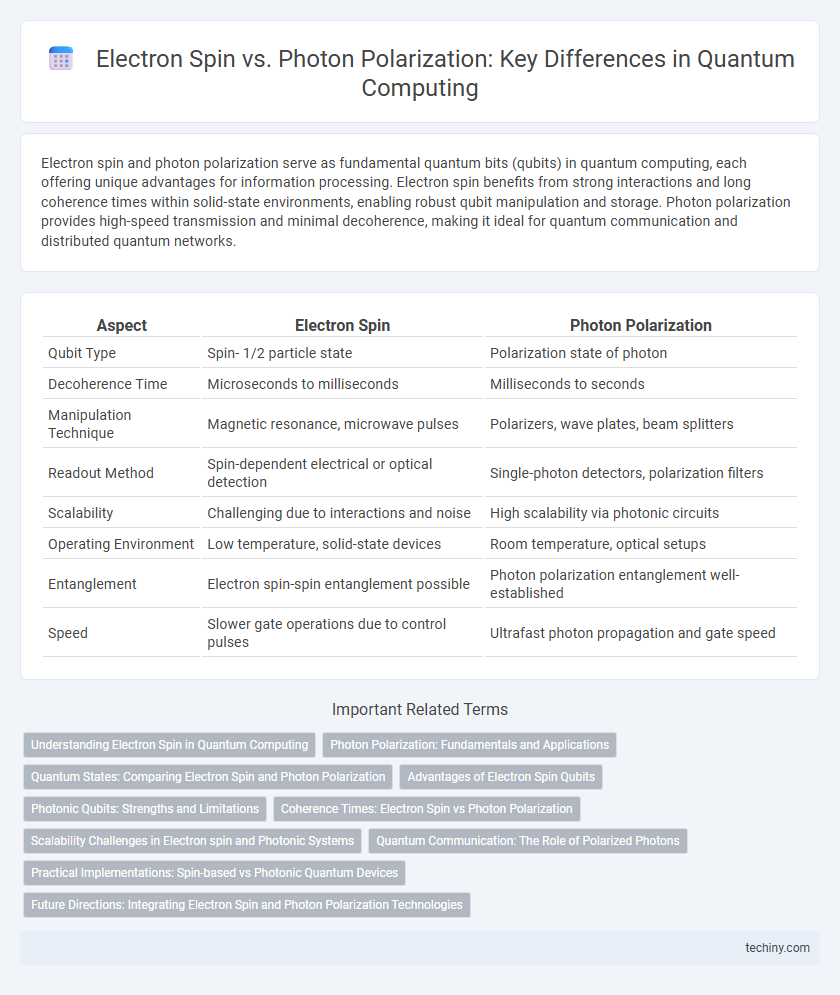Electron spin and photon polarization serve as fundamental quantum bits (qubits) in quantum computing, each offering unique advantages for information processing. Electron spin benefits from strong interactions and long coherence times within solid-state environments, enabling robust qubit manipulation and storage. Photon polarization provides high-speed transmission and minimal decoherence, making it ideal for quantum communication and distributed quantum networks.
Table of Comparison
| Aspect | Electron Spin | Photon Polarization |
|---|---|---|
| Qubit Type | Spin- 1/2 particle state | Polarization state of photon |
| Decoherence Time | Microseconds to milliseconds | Milliseconds to seconds |
| Manipulation Technique | Magnetic resonance, microwave pulses | Polarizers, wave plates, beam splitters |
| Readout Method | Spin-dependent electrical or optical detection | Single-photon detectors, polarization filters |
| Scalability | Challenging due to interactions and noise | High scalability via photonic circuits |
| Operating Environment | Low temperature, solid-state devices | Room temperature, optical setups |
| Entanglement | Electron spin-spin entanglement possible | Photon polarization entanglement well-established |
| Speed | Slower gate operations due to control pulses | Ultrafast photon propagation and gate speed |
Understanding Electron Spin in Quantum Computing
Electron spin serves as a fundamental quantum bit (qubit) in quantum computing due to its intrinsic two-state system, often represented as spin-up or spin-down. Unlike photon polarization, which relies on electromagnetic wave orientation, electron spin leverages the particle's magnetic moment for encoding and manipulating quantum information with high coherence times. This property enables precise control and entanglement necessary for scalable quantum algorithms and error correction protocols.
Photon Polarization: Fundamentals and Applications
Photon polarization, a fundamental property describing the orientation of the electromagnetic wave oscillations, plays a crucial role in quantum information processing and secure communication protocols such as quantum key distribution. Unlike electron spin, which is a two-level system confined to spin-up or spin-down states, photon polarization can be manipulated through various states including linear, circular, and elliptical polarizations, offering greater flexibility for encoding quantum bits (qubits). Practical applications of photon polarization extend to quantum cryptography, quantum teleportation, and photonic quantum computing, where polarization-encoded qubits enable high-speed, low-noise transmission of quantum information over optical fibers and free space.
Quantum States: Comparing Electron Spin and Photon Polarization
Electron spin and photon polarization represent fundamental quantum states used to encode quantum information, with electron spin described by a two-level system characterized by spin-up and spin-down states along a chosen axis. Photon polarization involves the orientation of the electromagnetic wave's oscillation, such as horizontal, vertical, or superposition states, forming the basis of qubit representation in optical quantum computing. These quantum states exhibit coherence and can be manipulated through magnetic or optical techniques, essential for quantum gate operations and entanglement generation across different quantum computing platforms.
Advantages of Electron Spin Qubits
Electron spin qubits offer superior coherence times compared to photon polarization qubits, enabling more reliable quantum information storage. Their strong interaction with magnetic fields allows precise manipulation and scalability in solid-state quantum devices. Moreover, electron spin qubits benefit from established semiconductor fabrication technologies, facilitating integration into existing computational architectures.
Photonic Qubits: Strengths and Limitations
Photonic qubits, encoded through photon polarization, offer high-speed transmission and intrinsic resistance to decoherence, making them ideal for long-distance quantum communication. Their ability to operate at room temperature and compatibility with existing fiber-optic infrastructure enhance scalability and integration potential. Limitations include challenges in deterministic photon-photon interactions and the need for efficient single-photon sources and detectors to achieve reliable quantum gate operations.
Coherence Times: Electron Spin vs Photon Polarization
Electron spin coherence times typically range from microseconds to milliseconds, influenced by interactions with the surrounding environment and material impurities in solid-state systems. Photon polarization coherence times can reach milliseconds to seconds in controlled optical setups, benefiting from minimal environmental interaction and high-speed manipulation. These differences in coherence times impact the choice of qubits for quantum computing architectures, with photon polarization favored for long-distance communication and electron spin preferred for scalable quantum memory and processing.
Scalability Challenges in Electron spin and Photonic Systems
Electron spin-based quantum computing faces scalability challenges due to the difficulty in maintaining coherent spin states and precise control over qubit interactions within dense arrays. Photonic systems offer inherent advantages in qubit transmission and reduced decoherence, but scaling photonic quantum networks requires complex integration of sources, detectors, and photonic circuits on-chip. Both systems demand breakthroughs in material science and error-correction protocols to achieve large-scale, fault-tolerant quantum computers.
Quantum Communication: The Role of Polarized Photons
Polarized photons serve as robust qubits in quantum communication due to their resilience against decoherence and ease of transmission over long distances through optical fibers. Electron spin qubits, while useful in quantum computing hardware, face challenges in maintaining coherence over communication channels. The intrinsic properties of photon polarization enable high-fidelity quantum key distribution and secure information transfer using protocols like BB84, making them essential for developing scalable quantum networks.
Practical Implementations: Spin-based vs Photonic Quantum Devices
Spin-based quantum devices leverage electron spin states to store and manipulate quantum information with high coherence times, making them suitable for scalable quantum processors in solid-state environments. Photonic quantum devices utilize photon polarization for qubit representation, offering advantages in room-temperature operation and long-distance quantum communication through optical fibers. Practical implementations of spin-based systems include quantum dots and nitrogen-vacancy centers in diamond, while photonic platforms rely heavily on integrated waveguides and beam splitters for efficient quantum state control and transmission.
Future Directions: Integrating Electron Spin and Photon Polarization Technologies
Future directions in quantum computing emphasize integrating electron spin and photon polarization technologies to leverage their complementary advantages for scalable qubit systems. Electron spin qubits provide long coherence times and strong interaction with magnetic fields, while photon polarization enables robust quantum communication over long distances due to low decoherence in optical fibers. Combining these platforms through hybrid quantum interfaces aims to enhance quantum error correction, improve entanglement distribution, and enable efficient quantum network nodes for distributed quantum computing.
Electron spin vs Photon polarization Infographic

 techiny.com
techiny.com